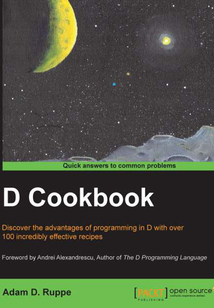舉報 

會員
D Cookbook
最新章節:
Index
Arecipepackedreferenceguidefilledwithpracticaltasksthatareconciselyexplainedtodevelopandbroadentheuser'sabilitieswiththeDprogramminglanguage.Ifyouareanexperiencedprogrammerwhoislookingtoexplorealanguagethatoffersplentyofadvantagesovermoreestablishedprogramminglanguages,thisisthebookforyou.Weassumethatyouarealreadyfamiliarwithgeneralprogramminglanguagebasics,butyoudonotneedtobeaproficientuserofD.
目錄(153章)
倒序
- coverpage
- D Cookbook
- Credits
- Foreword
- About the Author
- About the Reviewers
- www.PacktPub.com
- Support files eBooks discount offers and more
- Preface
- What this book covers
- What you need for this book
- Who this book is for
- Conventions
- Reader feedback
- Customer support
- Chapter 1. Core Tasks
- Introduction
- Installing the compiler and writing a "Hello World" program
- Adding additional modules (files) to your program
- Using external libraries
- Building and processing arrays
- Using associative arrays to translate input
- Creating a user-defined vector type
- Using a custom exception type
- Understanding immutability
- Slicing a string to get a substring
- Creating a tree of classes
- Chapter 2. Phobos – The Standard Library
- Introduction
- Performing type conversions
- Finding the largest files in a directory
- Creating a network client and server
- Using Base64 to create a data URI
- Generating random numbers
- Normalizing a string and performing Unicode comparisons
- Searching with regular expressions
- Writing a digest utility
- Using the std.zlib compression
- Using the std.json module
- Chapter 3. Ranges
- Introduction
- Using ranges when implementing an algorithm
- Creating an input range
- Creating an output range
- Creating a higher-order range
- Putting a range interface on a collection
- Creating an input range over a tree structure
- Using runtime polymorphic (class) ranges
- Storing a range as a data member
- Sorting ranges efficiently
- Searching ranges
- Using functional tools to query data
- Chapter 4. Integration
- Introduction
- Calling the Windows API functions
- Removing the Windows console
- Making Linux system calls
- Writing part of a C program in D
- Interfacing with C++
- Using structs to mimic the C++ object structure
- Communicating with external processes
- Communicating with a dynamic scripting language
- Using Windows' COM
- Chapter 5. Resource Management
- Introduction
- Avoiding the garbage collector
- Making a reference-counted object
- Manually managing class memory
- Using scope guards to manage transactions
- Creating an array replacement
- Managing lent resources
- Creating a NotNull struct
- Using unique pointers
- Using RAII and handling the limitations of class destructors
- Chapter 6. Wrapped Types
- Introduction
- Creating a struct with reference semantics
- Simulating inheritance with structs
- Creating a ranged integer
- Creating an opaque handle type
- Creating a subtyped string for i18n
- Forwarding methods with opDispatch
- Creating a tagged dynamic type
- Creating a structure with two views into the same data
- Simulating multiple inheritance with mixin templates
- Chapter 7. Correctness Checking
- Introduction
- Using assertions and exceptions
- Using static asserts
- Using template constraints and static if
- Preventing memory corruption bugs with @safe
- Leveraging const-correctness
- Avoiding side effects of pure functions
- Verifying object invariants and pre- and post-conditions
- Unit testing your code
- Documenting your code with Ddoc
- Writing platform-specific code (versions) and per-client configuration modules
- Chapter 8. Reflection
- Introduction
- Getting dynamic runtime type information
- Getting a list of child classes
- Determining whether a module is available
- Getting a list of all methods or fields in a module or an object
- Inspecting function overloads
- Determining names types and default values of function parameters
- Getting components of complex types
- Using user-defined attributes
- Implementing a custom lint-style check for virtual functions
- Extending the runtime type information
- Creating a command-line function caller
- Chapter 9. Code Generation
- Introduction
- Creating user-defined literals
- Parsing a domain-specific language
- Generating data structures from text diagrams
- Automating dynamic calls with multiple dispatch
- Building a lookup table
- Using string parameters to change functions
- Wrapping instance methods
- Using opDispatch to generate properties
- Duck typing to a statically-defined interface
- Chapter 10. Multitasking
- Introduction
- Using threads
- Passing messages with std.concurrency
- Processing parallel data with std.parallelism
- Using fibers
- Creating new processes
- Exploring thread-safe single-locking singletons
- Using asynchronous I/O
- Chapter 11. D for Kernel Coding
- Introduction
- Running D on bare metal x86 with a stripped runtime
- Adding interrupt handling to the bare metal x86 code
- Chapter 12. Web and GUI Programming
- Introduction
- Creating a dynamic website with cgi.d
- Creating a web API with web.d
- Parsing and modifying an HTML page with dom.d
- Accessing a SQL database
- Sending an e-mail
- Writing colored output to the console
- Getting real-time input from the terminal
- Working with image files
- Creating a graphics window to show a TV static demo
- Creating an OpenGL window
- Appendix A. Addendum
- Compiling D for ARM/Linux Raspberry Pi
- Running D on bare metal ARM
- Using the exponentiation operator
- Getting a stack trace without throwing an exception
- Finding more information about D
- Index 更新時間:2021-07-16 11:51:10
推薦閱讀
- Embedded Linux Projects Using Yocto Project Cookbook
- C語言程序設計實踐教程(第2版)
- R語言數據可視化之美:專業圖表繪制指南
- Learning AWS Lumberyard Game Development
- C語言程序設計
- Implementing Cisco Networking Solutions
- Python自然語言處理(微課版)
- C程序設計實踐教程
- JavaCAPS基礎、應用與案例
- JBoss:Developer's Guide
- SignalR:Real-time Application Development(Second Edition)
- ASP.NET Web API Security Essentials
- Java EE輕量級解決方案:S2SH
- Spring Boot學習指南:構建云原生Java和Kotlin應用程序
- Java面試一戰到底(基礎卷)
- Python面向對象編程(第4版)
- 零基礎學西門子PLC編程:入門、提高、應用、實例
- Python3網絡爬蟲寶典
- HoloLens Blueprints
- Hands-On Exploratory Data Analysis with Python
- Learning Bitcoin
- “笨辦法”學Python 3
- 超簡單:用Python讓Excel飛起來·核心模塊語法詳解篇
- C++碼農日記(全程視頻講解)
- 圖解交互設計UI設計師的必修課
- Java Web程序設計(慕課版)
- 區塊鏈原理、技術及應用
- Java EE輕量級框架應用開發教程
- Learning Tableau 10(Second Edition)
- Nuclio實戰及源碼分析:基于Kubernetes的Serverless FaaS平臺

